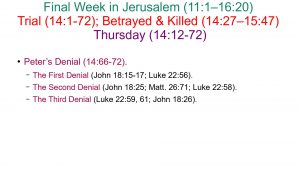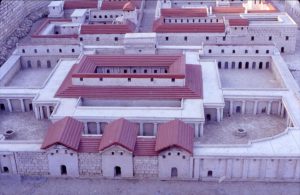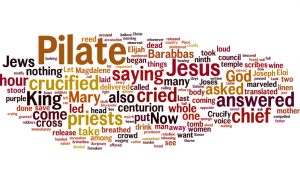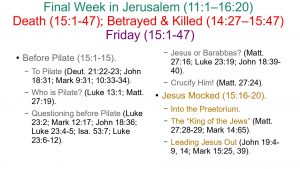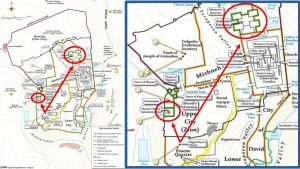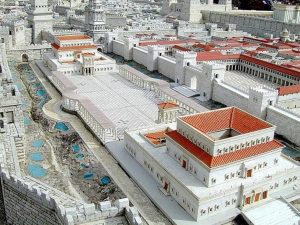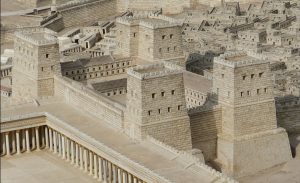Jesus’ Final Week in Jerusalem
Mark 11:1–16:20
Teaching (11:1–13:37)
King (11:1-11)
Sunday: Triumphal Entry (11:1-11).
Lawgiver (11:12–12:44)
Monday (11:12-19).
Tuesday (11:20–14:2).
Prophet (13:1-37)
Trial (14:1-72)
Sacrifice (14:1-26)
Wednesday (14:3-11).
Thursday (14:12-72)
The Passover (14:12-21).
The Last Supper (14:22-26).
Betrayed and Killed (14:27–15:47)
Peter’s Denial Prophesied (14:27-31).
Prayer in Gethsemane (14:32-42).
Betrayal and Arrest (14:43-52).
Trial Before Sanhedrin (14:53-65).
The first denial.
Recall, John somehow knew the high priest and his staff.
As a result, he let the servant girl who kept the door know to let Peter in (John 18:15-17).
She didn’t seem to question it at first, but while Peter is warming himself by the fire in the courtyard, she approaches him, looks at him intently, and asks if he were with Jesus (Luke 22:56).
She must have felt responsible since she let him in, and perhaps she wanted to make sure he wasn’t going to try anything and she get blamed for it.
Regardless, he denied it, even going so far as to say he doesn’t even understand her.
This is in the aorist tense, a past tense in Greek that shows something completed in the past. It was a one-time thing.
 A tell for when one is lying is that fight or flight response, and he chose to flee, going out to the porch by the street.
A tell for when one is lying is that fight or flight response, and he chose to flee, going out to the porch by the street.Then the rooster crowed the first time. Recall, this was a random time of the night, sometime after midnight.
In any event, the crowing didn’t phase Peter at all as he didn’t seem to register it at the time.
The second denial.
Peter must have come back in by the fire as John records (John 18:25).
That same servant girl just couldn’t let it go—she was confident this was a disciple of Jesus.
And instead of confronting him directly, she tells others about it and they confront him about it, including another servant girl (Matt. 26:71) and perhaps a man (Luke 22:58).
The first denial was done just once, but this denial is in the imperfect tense, a continual past tense. He kept on denying him.
So this was several people confronting him after this servant girl outed him to others, and he continuing to deny it.
The third denial.
Luke informs us that an hour passes between the second and third denials (Luke 22:59).
John says that a servant of the high priest and a relative of the one that Peter struck called Peter out for this third denial (John 18:26).
They were confident that he was with Jesus, not just because this servant saw him, but also because he spoke like a Galilean.
Apparently he spoke with an accent or a dialect that betrayed his Galilean background, and what reason would a Galilean have here right now accept because of Jesus?
This time he was all the more vehement about his denial, his heels were dug in.
He was so vehement he “began to curse and swear.”
When we think of someone swearing and cursing, we often think of someone just using profanity, but that’s not the sense here.
The ESV says that, “he began to invoke a curse on himself and swear.”
That is a possibility, that Peter was saying something like, “May God strike me down if I’m lying.”
But this is not the only possibility. Another way Peter could have cursed and swore was to curse and swear against Jesus to show that he isn’t one of His disciples.
While Jesus is placed under oath and speaks the truth, Peter utters an oath on his own to speak a lie.
While Jesus shows His resolve under intense questioning, threats, and beatings, Peter buckles under light questioning.
Somehow Jesus and Peter lock eyes as the rooster crows a second time (Luke 22:61).
Have you ever caught the tail end of a conversation and it sounded really bad? It probably wasn’t what you thought, but you couldn’t be sure.
Well, this is exactly what Jesus thought as He hears Peter swearing his denial of Him.
What do you think Jesus expression was here? One of pain and hurt? Or one of love and understanding? Perhaps one of disappointment?
Whatever that look is, Peter sees it and all His emotions are no doubt conveyed to his most faithful disciple, the one who saw Him raise the dead, be transfigured before him, and pray an earnest and heartfelt prayer of sorrow and grief in anticipation of what was about to happen.
Peter did all that and still couldn’t find the courage to confess that he knows Jesus, that he believes He is the Christ, the Messiah, the Son of the living God.
He said that he would die for Him, and in that moment, he failed to live up to his bluster.
Jesus’ prophecy came true, and he was ashamed, hearing the rooster, and seeing His Lord beaten and bloodied, so he went out and wept bitterly.
That rooster signaled that dawn was fast approaching, as we’ll see in the next verse.
Death (15:1-47)
Before Pilate (15:1-15).
To Pilate (15:1).
After the rooster crowed, dawn was fast approaching, and the Jewish leaders were finally making their decision on what to do with Jesus.
They already sentenced Him to death, but they knew it wouldn’t be an easy sentence to carry out given their Roman overlords and the love of the people.
These leaders clearly wanted the gruesome, agonizing, and very public death that the cross would afford them—not to mention such people were shown to be cursed (Deut. 21:22-23).
This meant that this means of death signaled to everyone that this person committed a very wicked deed.
 He was accused of blasphemy, which was quite severe in Jewish law.
He was accused of blasphemy, which was quite severe in Jewish law.At this time, only the Romans could execute someone in such a manner (John 18:31).
So these Jewish leaders were in the process of carrying out this plot to get the Romans to crucify Jesus—they just needed Pilate’s support and that of the people to convince Pilate.
This was done at around 5 or 6 a.m., quite early on Friday morning.
It was as Jesus said: He was delivered to the chief priests by Judas, who in turn delivered Him to the Gentiles (that is Pilate), who then would deliver Him up to be mocked, scourged, and crucified (cf. Mark 9:31; 10:33, 34).
 It is unclear where Pilate conducted this questioning during this time.
It is unclear where Pilate conducted this questioning during this time.There are two contenders: Herod’s Palace and the Antonia Fortress.
The Antonia Fortress is where these things were normally held, but since when is this a normal procedure?
The traditional location is Herod’s Palace, which is right across from the Praetorium, and in between that and the high priest’s residence—it is a logical place for Pilate to have questioned Jesus.

Herod’s Palace in the foreground; the Praetorium in the background on the left; the Temple Complex and Antonia Fortress in the background on the right. 
Antonia Fortress by the Temple Complex
